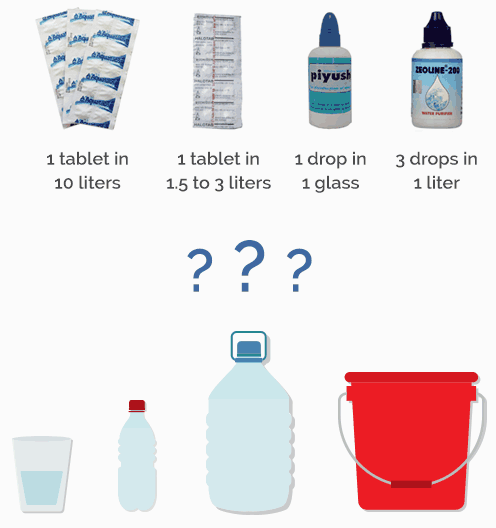Chlorine Facts
Chlorine was used for the first time in 1850 in London’s water distribution system to combat cholera. Similarly in some American cities started chlorination around 1908, a step which significantly decreased the number of deaths caused by cholera, typhoid, diarrhoea and hepatitis A. Today chlorination is used to treat most of drinking water in the world since it is easy, inexpensive and reliable. Chlorine is available in different countries with different brand and names.
Though chlorine is widely applied for centralized disinfection of drinking water in municipal water supply systems in developed countries, most developing countries do not have the infrastructure required for supply of treated piped water to each and every household. Governments in developing countries and International agencies have been trying to promote chlorination at household level as an effective and simple treatment option for drinking water.
According to World Health Organisation – Chlorination is the most cost effective method of disinfecting biologically contaminated drinking water. Additionally, chlorinated water prevents recontamination of water during transportation and storage.

However, since chlorine tablets and chlorine drops come in different strengths (brand specific) the users have to be aware and be literate enough to know how many tablets or drops are to be added to different volumes of water that they collect in different containers like bottles, jerry cans or buckets.

A correct amount of chlorine solution must be used. If the concentration of chlorine is inadequate the solution may fail to destroy all the harmful disease causing pathogens and if in excess, may result in an unpalatable taste and smell. Only an appropriate amount of chlorine can destroy most of harmful pathogens and provide a safe amount of residual chlorine. Chlorine that does not does not combine with other components and remain in water is called ‘Free Residual Chlorine’ (FRC). FRC makes sure that water which has been treated by chlorination will not get re-contaminated when being transported or stored.
-
Zimba and Chlorine:
Sodium Hypochlorite solution (NaOCl), commonly known as bleach has to be used with Zimba. It is available under different brand names in different counties and regions, and comes in different strengths (usually expressed in % w/v). Zimba is compatible with even the weakest solutions that are available. Depending on the strength, the ‘dose adjustment slider’ in a Zimba has to be set, to get the required level of chlorine in the output water of Zimba. Once topped up Zimba can treat 10,000 to 20,000 litres of water (depending on the strength of the available solution) before refilling would be required. In case of any difficulty, the Zimba team will be happy to guide our users in getting the right dose.
-
Sourcing Chlorine:
Ask the people who supply laboratory chemicals to schools and colleges, if you find it difficult finding chlorine solution off the shelf. If you are using household bleach make sure it does not contain any chemical other than Sodium Hypochlorite. Chlorine can also be produced locally by electrolysis of brine (common salt in water). Commercial electro-chlorinators of different capacities are also available for producing chlorine solution at site.
-
Chlorine Measurement:
The output water of Zimba should be checked for ‘Free Residual Chlorine’ (FRC) level, after installation and before a community starts using it. As per ‘Centers for Disease Control and Prevention’ the FRC level should be as noted below.
• At 30 minutes after the addition of sodium hypochlorite there should be no more than 2.0 mg/L of free chlorine present (this ensures the water does not have an unpleasant taste or odor).
• At 24 hours after the addition of sodium hypochlorite to containers that are used by families to store water there should be a minimum of 0.2 mg/L of free chlorine present (this ensures microbiologically safe water).
The Zimba team will be happy to assist you in procuring any of the test kits mentioned here, but it should be kept in mind that what needs to be measured is the FRC and not the total chlorine in the water.
-
Chlorine Storage:
Sodium hypochlorite is highly reactive and volatile. Never store the solution in any metallic container as chlorine will react with the metal. Sodium hypochlorite should be stored or transported always in opaque plastic containers to prevent exposure of the solution to UV radiation from sunlight, which will decrease its shelf life. In case the available chlorine solution is of a higher concentration than what is needed in the Zimba unit, you may have to dilute it appropriately with water. Never store diluted chlorine – dilute the solution at site just before refilling. Dilution reduces the pH value, which makes the solution unstable and thereby reduces shelf life. Sodium Hypochlorite solutions are comparatively stable at pH values above 11 when stored in opaque plastic containers.